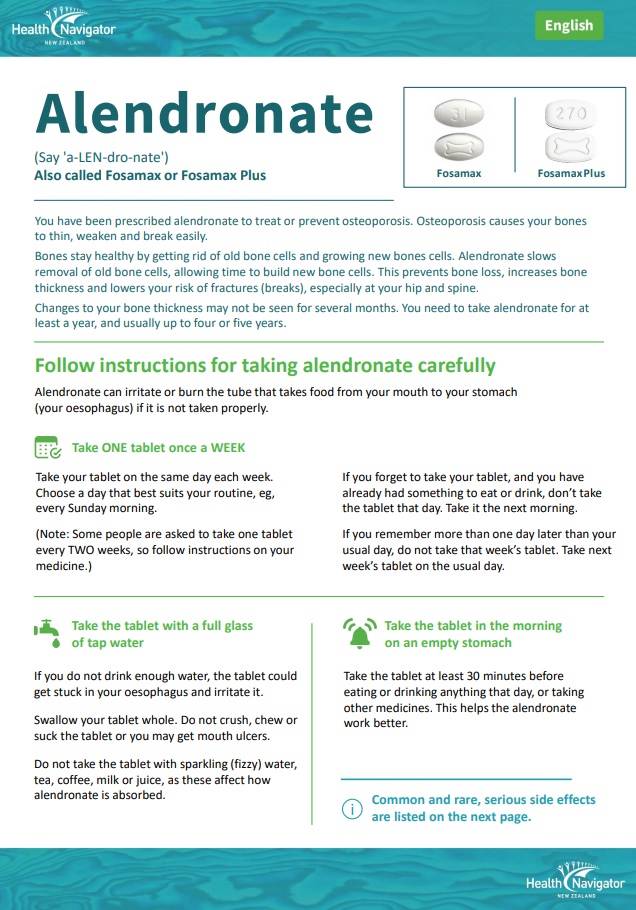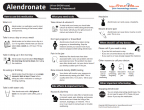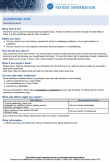Alendronate
Sounds like 'a-LEN-dro-nate'
Key points about alendronate
- Alendronate is used to treat and prevent conditions affecting bones such as osteoporosis.
- Alendronate is also called Fosamax.
- Find out how to take it safely and possible side effects.

Alendronate is used to treat bone disease such as osteoporosis and Paget's disease.
- Osteoporosis is a condition that causes your bones to be thinner and weaker than normal. This means that they can break (fracture) easily, such as after a small bump or fall. In osteoporosis alendronate prevents bone loss, increases bone thickness and lowers your risk of spine and hip fractures.
- In Paget's disease, abnormal bone growth causes deformity and pain. Alendronate can help with this.
Alendronate belongs to a group of medicines known as bisphosphonates. In Aotearoa New Zealand alendronate is available as tablets (70 mg and 40 mg) and in combination with vitamin D called Fosamax Plus.
Watch a video about alendronate for osteoporosis.
(RheumInfo(external link), Canada, 2019)
- Always take your alendronate exactly as your doctor has told you. The pharmacy label on your medicine will tell you how much alendronate to take, how often to take it, and any special instructions.
- Osteoporosis: The usual dose of alendronate for the treatment of osteoporosis is 70 mg (1 tablet) ONCE A WEEK (every 7 days).
- Paget's disease: The usual dose for Paget's disease is 40 mg once a day.
It is very important that you carefully follow the instructions of how to take alendronate safely. If not taken properly, alendronate can irritate or burn the food pipe (or oesophagus).
- Day of the week: If you are taking alendronate once a week, take it on the same day each week. To help you remember choose a day that best suits your routine, for example every Monday.
- Time of the day: Take alendronate first thing in the morning, before eating or drinking anything else, including other medicines. Do not take alendronate at bedtime or while lying in bed.
- Take alendronate with a full glass of water. Do not take your alendronate tablet with mineral water, tea, coffee, milk or juice, as these interfere with the absorption of alendronate into your body.
- Swallow the tablet whole. Do not crush or chew the tablet. Mouth ulcers may occur if the tablet is chewed or dissolved in the mouth.
- Stay upright for at least 30 minutes after taking alendronate. Do not lie down for at least 30 minutes, and do not take any food, drinks or medicines during this time.
If you forget to take your alendronate
- Weekly dose: Take the missed dose if you remember the next morning. If not, skip the dose and take the next week’s dose at the usual time.
- Daily dose: Skip the missed dose and take the next day’s dose at the usual time.
If you are unwell
If you are unwell and cannot sit or stand upright for 30 minutes after taking alendronate, skip that day’s dose and do not take it until you are feeling better. Contact your doctor or pharmacist if you need to miss more than 2 or 3 doses.
Here are some things to know when you're taking alendronate. Other things may be important as well, so ask your healthcare provider what you should know about.
- Other medicines: alendronate interacts with some medications, herbal supplements and rongoā Māori, so check with your doctor or pharmacist before starting alendronate and before starting any new products.
- Some medicines available without a prescription may interact with alendronate such as calcium supplements, iron supplements and antacids.
- Maintain good oral hygiene (such as brushing your teeth twice a day and regular flossing between your teeth). Read more about this in the section on possible side effects below.
Like all medicines, alendronate can cause side effects, although not everyone gets them. Often side effects improve as your body gets used to the new medicine.
Problems with your jaw
Alendronate can cause osteonecrosis of the jaw. This is a problem with the jaw that can be caused by delayed healing in the mouth after some dental procedures. This is quite rare. To reduce the risk of this problem, it is best to:
- Take good care of your teeth and mouth (such as brushing your teeth twice a day and regular flossing between your teeth).
- Have regular dental check-ups.
- If you need any dental treatment, it is best that you have this done before you start treatment with alendronate.
- Let your dentist know that you are taking alendronate.
- Talk to your doctor or dentist if you have any loose teeth, tooth pain, or swelling or numbness in your jaw.
Fractures
Alendronate can rarely causes fractures in your thigh bone (upper leg bone). These are called atypical fractures because they appear as cracks on the bone and are not usually related to an injury. If you have pain, weakness or discomfort in your thigh, hip or groin, tell your doctor. These pains may be warnings that there is some weakness in your bones. You may need Xrays of your legs.
Other side effects
| Side effects | What should I do? |
|---|---|
|
|
|
|
|
|
| Read more about medicines and side effects and reporting a reaction you think might be a side effect. | |
References
- Alendronic acid(external link) NZ Formulary [accessed April 2017]
- Osteoporosis treatments and atypical femur fracture(external link) Medsafe Prescriber Update 34(1): 5-6 March 2013
- Osteonecrosis – a pain in the jaw(external link) Medsafe Prescriber Update 33(2): 13-14 June 2012
- Osteonecrosis of the jaw And bisphosphonates – putting the risk in perspective(external link) Medsafe Publications, October 2007
- Reminder: Keeping an eye on bisphosphonates(external link) Medsafe Prescriber Update 32(3): 24 September 2011
- An update on bisphosphonates(external link) BPAC, November 2014
- Fosamax(external link) Medsafe Datasheet
Brochures
 Alendronate factsheet
Alendronate factsheet
Healthify He Puna Waiora, NZ, 2021

Alendronate
Rheuminfo, 2022
 Alendronic acid
Alendronic acid
NZ Formulary Patient Information Medsafe Consumer Information Sheets, 2023
Credits: Sandra Ponen, Pharmacist, Healthify He Puna Waiora. Healthify is brought to you by Health Navigator Charitable Trust.
Reviewed by: Angela Lambie, Pharmacist, Auckland
Last reviewed:
Page last updated:





